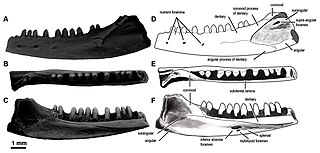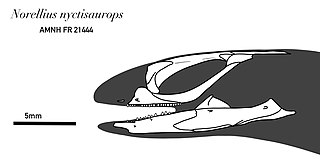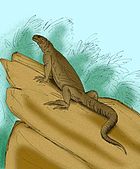
Goyocephale is an extinct genus of pachycephalosaurian ornithischian that lived in Mongolia during the Late Cretaceous about 76 million years ago. It was first described in 1982 by Altangerel Perle, Teresa Maryańska and Halszka Osmólska for a disarticulated skeleton with most of a skull, part of the forelimb and hindlimb, some of the pelvic girdle, and some vertebrae. Perle et al. named the remains Goyocephale lattimorei, from the Mongolian гоё (goyo), meaning "decorated", and the Ancient Greek κεφαλή (kephale), for head. The species name honours Owen Lattimore.

Estesia is an extinct genus of Late Cretaceous anguimorph lizard found in the Gobi Desert in Mongolia.
Gobiderma is an extinct genus of Late Cretaceous lizard whose fossils are known from the Gobi Desert in southern Mongolia. It was first discovered as a result of a joint Polish-Mongolian Paleontological Expedition, and formally named in 1984. In life, it probably resembled lizards of the genus Heloderma to a large degree, though its skull was more elongated than lizards of that genus.
Ovoo gurvel is an extinct varanid lizard from the Late Cretaceous of Mongolia. It is one of the smallest and earliest monitor lizards. It was described in 2008. Ovoo possesses a pair of two small bones in its skull that are not seen in any other lizard.
Aiolosaurus is an extinct genus of monitor lizard from the Late Cretaceous of Mongolia. The type and only species, Aiolosaurus oriens, was named in 2000 from Ukhaa Tolgod, a rich fossil site in the Campanian-age Djadochta Formation.

Telmasaurus is an extinct genus of varanoid lizard from the Late Cretaceous of Mongolia. Fossils have been found from the Djadokha and Barun Goyot Formations that date between the early and middle Campanian stage from approximately 80 to 75 million years ago. The type species Telmasaurus grangeri was named in 1943.
Proplatynotia is an extinct genus of varanoid lizard from the Late Cretaceous of Mongolia. Fossils have been found in the Barun Goyot Formation, which is mid-Campanian in age. The type and only species, P. longirostratia, was named in 1984.
Myrmecodaptria is an extinct genus of scleroglossan lizard from the Late Cretaceous Djadokhta Formation in Ukhaa Tolgod, Mongolia. The type and only species, Myrmecodaptria microphagosa, was named in 2000 by paleontologists Gao Keqin and Mark Norell. Myrmecodaptria is known from a single holotype skull and lower jaws. It is distinguished from all other lizards by its extremely elongated skull. The eyes are placed close to the snout, which is short and rounded. The top of the skull is covered in bony knobs called osteoderms. The parietal bone at the back of the skull is elongated and about as long as the frontal bones, which are the usually the longest bones along the top of the skull in lizards. The squamosal bone at the back of the skull reaches forward to connect with the jugal bone behind the eye, forming a thin arch between the temporal fenestrae. Myrmecodaptria also has fewer and more widely spaced teeth in its jaws than do most other lizards.
Carusia is an extinct genus of lizards from the Late Cretaceous of Mongolia. It is a close relative of the family Xenosauridae, which includes living knob-scaled lizards. Fossils of the type and only species Carusia intermedia come from the late-Campanian age Barun Goyot Formation and have been found in the Flaming Cliffs, Ukhaa Tolgod, and Kheerman Tsav fossil localities. Carusia was first described in 1985 under the name Carolina intermedia, but since the name Carolina was preoccupied by a genus of scarab beetles that had been named in 1880, it was renamed Carusia intermedia. Carusia had initially been known from fragmentary skull material, complicating efforts to determine its evolutionary relationships with other lizards; it had variously been described as an indeterminate scincomorph, a xenosaurid, or some other type of autarchoglossan lizard convergent with xenosaurids. However, the discovery of 35 complete skulls in the 1990s, three of which were described in a detailed 1998 monograph, revealed that Carusia was the sister taxon of Xenosauridae, compelling the authors of the monograph to create a new clade called Carusioidea to include both taxa.
Priscagamidae is an extinct family of iguanian lizards known from the Late Cretaceous of Mongolia and China and the Eocene of India, spanning a range from 75 to 54 million years ago. It includes the genera Heterodontagama, Mimeosaurus, Phrynosomimus, Priscagama, and possibly Pleurodontagama. The first fossils of priscagamids were found in the Djadochta and Khermeen Tsav formations of Mongolia. More recently they have been found in the Cambay Formation in India, leading to the naming of Heterodontagama in 2013. Priscagamidae was originally described as a subfamily of Agamidae called Priscagaminae in 1984, but it was reclassified as a distinct family in 1989. Most phylogenetic analyses still find a close relationship between Priscagamidae and Agamidae, although a 2015 study found it to be basal to all other iguanian clades, warranting its removal from Iguania and placement in a larger clade called Iguanomorpha.
Heterodontagama is an extinct genus of iguanian lizard from the Early Eocene of India. It belongs to the extinct family Priscagamidae, which is otherwise only known from the Late Cretaceous of Mongolia. The type species Heterodontagama borsukae was named in 2013 from several isolated upper and lower jaws found in an exposure of the Cambay Shale in an open-pit coal mine in Gujarat.
Saichangurvel is an extinct genus of iguanian lizards from the Late Cretaceous of Mongolia. It is a member of a clade called Gobiguania, an exclusively Late Cretaceous group of iguanian lizards that was likely endemic to the Gobi Desert. The type species, Saichangurvel davidsoni, was named by paleontologists Jack Conrad and Mark Norell of the American Museum of Natural History in 2007. It is known from a single nearly complete and fully articulated skeleton called IGM 3/858, which was found eroding from a block of sandstone during a thunderstorm at a fossil locality called Ukhaa Tolgod. IGM 3/858 comes from the Djadochta Formation, which is between 75 and 71 million years in age. Just as it is today, the Gobi was a desert during the Cretaceous. IGM 3/858 may have died in a collapsing sand dune, the rapid burial preserving its skeleton in pristine condition.
Pleurodontagama is an extinct genus of iguanian lizard from the Late Cretaceous of Mongolia. The type species, Pleurodontagama aenigmatodes, was named in 1984 on the basis of a mostly complete skull and isolated lower jaw from a fossil locality called Khermeen Tsav. It has a wide skull with a flat snout, large eye sockets, and small bumps on the surfaces of the bones. Pleurodontagama was initially classified in the family Priscagamidae, which is usually grouped in a large clade of iguanians called Acrodonta, members of which are characterized by an "acrodont" dentition in which the teeth grow from the margins of the jaws. However, Pleurodontagama is unusual in that it has a sub-pleurodont dentition, meaning that some of its teeth grow from the inner surfaces of the jaw. There is also evidence to suggest that its teeth may have been continuously replaced throughout life, as opposed to the permanent teeth of acrodontans. Pleurodontagama may have been a transitional form between the derived acrodont type and the pleurodont type inferred for the ancestors of Acrodonta.
Priscagama is an extinct genus of iguanian lizard from the Late Cretaceous of Mongolia and China. It belongs to an extinct family of iguanians called Priscagamidae. Several incomplete skulls have been found in the Barun Goyot and Djadochta formations, and were originally referred to the genus Mimeosaurus; the type species Priscagama gobiensis was named in 1984 when it was recognized that these skulls belonged to a distinct species. Priscagama differs from most other priscagamids in having a more elongate, lightly built skull. It is very similar in appearance to another priscagamid called Pleurodontagama, as the two can only be distinguished by the shape of their teeth.
Anchaurosaurus is an extinct genus of iguanian lizard from the Late Cretaceous of Inner Mongolia, China. It belongs to an extinct clade of iguanians called Gobiguania that was endemic to the Gobi Desert during the Late Cretaceous. The type species, Anchaurosaurus gilmorei, was named in 1995 on the basis of a well-preserved skull and incomplete skeleton from the Djadochta Formation. Compared to other iguanians, Anchaurosaurus has a relatively elongated skull, large eye sockets, and higher tooth crowns. Phylogenetic analysis indicates that among gobiguanians, Anchaurosaurus is most closely related to Zapsosaurus from Mongolia. Below is a cladogram from Daza et al. (2012) showing the phylogenetic relationships of Anchaurosaurus:
Xihaina is an extinct genus of iguanian lizard from the Late Cretaceous of Inner Mongolia, China. The type species Xihaina aquilonia was named in 1995 from the Djadochta Formation and is known from a partial skeleton that preserves parts of the skull, most of the vertebral column, the pelvis, and the right hind limb. The incomplete nature of this specimen makes the classification of Xihaina difficult; it has never been incorporated into a phylogenetic analysis, but it shares similarities with a group of Late Cretaceous Mongolian lizards called Gobiguania, particularly the gobiguanian genera Anchaurosaurus and Polrussia. The fact that many skeletal elements are missing yet the rest of the skeleton is articulated suggests the individual may have been partially eaten by a predator or scavenger and then rapidly buried soon after.
Polrussia is an extinct genus of iguanian lizards dating to the Late Cretaceous epoch, found in what is now Mongolia. It belongs to a group of extinct iguanians called Gobiguania that was endemic to the Gobi Desert during the Late Cretaceous. The type species Polrussia mongoliensis was named in 1991 on the basis of a skull found in the Barun Goyot Formation. The genus name refers to the Polish and Russian paleontologists who worked together to find and describe the material. Polrussia has a short skull, slightly pointed and flattened snout, and large eye sockets. The teeth each have one cusp, as opposed to the multiple cusps seen in some other gobiguanians. The skull is only 1.2 centimetres (0.47 in) long, making Polrussia one of the smallest gobiguanians.

Igua is an extinct genus of iguanian lizards belonging to a group called Gobiguania that was endemic to the Gobi Desert during the Late Cretaceous. The type species Igua minuta was named in 1991 on the basis of a skull from the Barun Goyot Formation in Mongolia. The skull itself is very small, only 14 millimetres (0.55 in) long, and may have belonged to a juvenile given that it possesses a large fontanelle and that many of the bones are unfused. The snout-vent length of the individual is estimated to have been 55 to 65 millimetres. Igua differs from related gobiguanians like Polrussia in having a more rounded skull. It is similar in appearance to the living genera Liolaemus and Tropidurus. The teeth are tricuspid and pleurodont, meaning they are attached to inner surfaces of the jaws.

Paramacellodidae is an extinct family of lizards that first appeared in the Middle Jurassic around 170 million years ago (Ma) and became extinct at the end of the Cretaceous around 66 Ma. It was one of the earliest groups of lizards to have undergone an evolutionary radiation, with members found across the supercontinent Laurasia. The phylogenetic relationships and constituent species of Paramacellodidae are uncertain. Many studies regard them to be scincomorphs, a large group that includes skinks and their closest extinct relatives, and possibly also to Cordyoidea, a group that includes spinytail lizards and relatives. Like modern skinks, paramacelloidids had rectangular bony plates called osteoderms covering most of their bodies, including their backs, undersides, and tails. They also had short and robust limbs. Paramacellodids are distinguished from other lizards by the combination two traits in their dentition, the teeth are labiolingually expanded at their bases, and the tooth apices are lingually concave.

Norellius is an extinct genus of scleroglossan lizard from the Early Cretaceous Öösh Formation of Mongolia. It is known from a well-preserved skull that was collected by an American Museum of Natural History expedition to Mongolia in 1923 and cataloged as AMNH FR 21444. After its initial cataloging, the specimen was not mentioned again in the scientific literature until 2004, when it was recognized as belonging to a potential early relative of modern groups of squamates such as gekkotans, amphisbaenians, dibamids, and snakes. AMNH FR 21444 was more fully described in a 2006 study that used high-resolution computed tomography to examine the skull and its braincase, and was described as a new genus and species, Norellius nyctisaurops, in 2015. The genus name honors paleontologist Mark Norell. The 2006 study incorporated the specimen into a phylogenetic analysis and found it to be a basal member of an evolutionary grouping called Gekkonomorpha, a stem-based taxon that includes living geckos and legless lizards (pygopodids) and all taxa more closely related to them than to any other living lizard. Norellius lies outside the node-based taxon Gekkota, a more strictly-defined subgroup of Gekkonomorpha that includes geckos, pygopodids, and all descendants of their most recent common ancestor. Therefore, while Norellius is more closely related to geckos and pygopodids than it is to any other living group of lizards, it branched off before the most recent common ancestor of these two groups. Below is a cladogram showing the position of Norellius according to this phylogeny:






